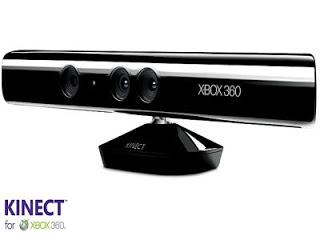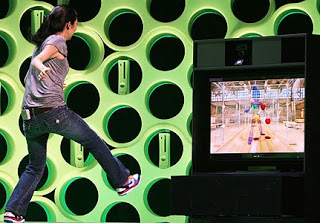This post has not been edited by the GamesBeat staff. Opinions by GamesBeat community writers do not necessarily reflect those of the staff.
 Editor's note: I hate it when gamers write off things without considering the possibilities new technologies can bring to our beloved hobby. I like the ideas Jon lays out in this piece — especially his second point. I know many of you would enjoy watching the histrionics I go through when I suffer a frustrating death in a game. -Jason
Editor's note: I hate it when gamers write off things without considering the possibilities new technologies can bring to our beloved hobby. I like the ideas Jon lays out in this piece — especially his second point. I know many of you would enjoy watching the histrionics I go through when I suffer a frustrating death in a game. -Jason
Far from being E3's defining moments, the motion-controller demonstrations left me feeling a little disappointed. I've said it before, and I'll say it again: Both Sony and Microsoft (the latter, especially) have divided their audience squarely into two. The casual audience, they've decided, are only interested in casual, motion-controlled experiences, while the "core" audience just wants more guns, more explosions, and generally more of the same.
This is depressing to me because these stereotypes have been proven wrong time and time again. Casual games draw people without some goofy peripheral if they're genuinely fun to play (à la Peggle). Meanwhile, "hardcore" gamers want a little variety with their bald space marines.
Microsoft's Kinect has the potential to add to existing gameplay experiences, but it's a shame the potential is all being used on games aimed at nongamers. Nothing's wrong about this, of course – more people playing games is a good thing no matter what – but I can't help but think there's so much more that can be explored.
What if games noticed your body rather than just your hands?
Some people out there jump at loud noises in horror games (myself included). Other gamers are braver, and for them playing a horror game is a much less tense experience. Jumping in fear is something that Kinect could register and use to adapt the game's experience to the player. It could give a scared mess of a player a slightly easier time than someone who's sitting there stoically playing through the game.
Similarly if someone's beating their controller to a pulp in frustration, why not subtly remove a couple of enemies in their path, or reduce the rubber-banding in your racing game by a couple of fractions to ease them through the challenge without making them feel like a cheat.
A more basic application of Kinect could be its use as a glorified pause button. Going to the kitchen for a sandwich? Kinect will notice you get up and pause the game for you. Switching controllers between players during a frantic splitscreen session of Halo? Kinect will pause it until you're all comfortable.
What if Kinect put you into games that were actually good?
Your average game has dozens of screens dotted around levels showing fake television shows or mission coordinators. Kinect (or the PlayStation Eye, for that matter) could really mess with you by chucking your image into these. Walking past an image of yourself gaming in a virtual shop window is a surreal experience, I can tell you.
OK, so maybe that suggestion's a little lame, but what about the potential for identifying your teammates as something more than just a screen name and an annoying accent. In Grand Theft Auto 4's multiplayer, remember how you could call up people on your phone to intimidate your enemies? What about if you were able to video call them for that added terror of knowing your enemy can see you in your undies?
The characters of driving games are traditionally a very stationary lot. The most you usually get out of them is a movement of the arm to change gear, but aside from that they just sit there, much like you are at home. How about imbuing these static avatars with a little more character, directly from the gamer at home? MotorStorm has a taunt button that allows you to shake your fist at other racers when on the back of a motorcycle. What if the character copied your own movements at home, giving the finger to other racers as the pass you online, or gloating as you left them in your dust? It would also be that much more menacing to see someone flick you the bird as they pass, knowing that the player at home had to take one of his hands off his controller to get it to work rather than just press a button.
The ability to scan objects was one of the potential features shown of by Microsoft at 2009's E3, with the example of a kid holding his skateboard up to the screen to get the graphic directly into the game. Lame as it sounds, it might actually be fun to have more of that kind of thing. What if Niko's clothes were a replica of an outfit in your wardrobe? Developers could take this feature further in games like The Sims, where it would become much easier to get your exact duvet design (snakes and ladders, in my case) on your Sim's bed.
Kinect has the potential to turn many of these games we're already familiar with into much more personal experiences, but it's a shame no one seems to have given the possibilities much thought.
Sex faces
Speaking from personal experience, gamers tend to make a lot of stupid faces while playing. This stupidity isn't limited to their countenances, however, as my heroic end-of-a-difficult-level dances will attest to.
Most of these things are pretty embarrassing, which means they also have the potential to be quite amusing. Much in the same way as Burnout: Paradise, games could record you at key moments to capture that heartbreaking moment you missed the last jump in a lengthy Prince of Persia sequence. On the flip side, I'd gladly watch back some of my victory dances weeks after getting a platinum ranking in Bayonetta.
Stupid though many of these ideas are, they do show that with a little out-of-the-box thinking, a peripheral that most gamers have passed as being "not for them" could enrich their favorite games in ways they'd never thought possible.
We haven't even come close to seeing the dozens of Kinect-enabled games promised to us by industry analyst Michael Pachter, so to write off the device at this point could be excluding yourself from one of the most potentially interesting developments in console gaming this side of rumble.
As always, time will tell.


